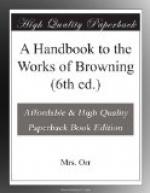The Jew turned like a trodden worm. “Truly,” he replied, “a miracle has been wrought, by a power which no canvas yet possessed, in that I have resisted the desire to throttle you. But my purchase of your picture is not due to a miracle. It means simply that I have been cured of my prejudices in respect to art. Christians hang up pictures of heathen gods. Their ‘Titians’ paint them. A cardinal will value his Leda or his Ganymede beyond everything else which he possesses. If I express wonder at this sacrifice of the truth, I am told that the truth of a picture is in its drawing and painting, and that these are valued precisely because they are true. Why then should not your Mary take her place among my Ledas and the rest; be judged as a picture, and, since—as I fear—Master Buti is not a Titian, laughed at accordingly?”
“So now,” the speaker concludes, “Jews buy what pictures they like, and hang them up where they please, and,”—with an inward groan—“no, boy, you must not pelt them.” This warning, which is supposed to be addressed by the historian in his old age to a nephew with a turn for throwing stones, reveals the motive of the story: a sudden remembrance of the good old pious time, when Jews might be pelted.
“UP AT A VILLA—DOWN IN THE CITY” is a lively description of the amusements of the city, and the dulness of villa life, as contrasted by an Italian of quality, who is bored to death in his country residence, but cannot afford the town. His account of the former gives a genuine impression of dreariness and monotony, for the villa is stuck on a mountain edge, where the summer is scorching and the winter bleak, where a “lean cypress” is the most conspicuous object in the foreground, and hills “smoked over” with “faint grey olive trees” fill in the back; where on hot days the silence is only broken by the shrill chirp of the cicala, and the whining of bees around some adjacent firs. But the other side of the picture, though sympathetically drawn, is a perfect parody of what it is meant to convey. For the speaker’s ideal “city” might be a big village, with its primitive customs, and its life all concentrated in the market-place or square; and it is precisely in the square that he is ambitious to live. There the church-bells sound, and the diligence rattles in, and the travelling doctor draws teeth or gives pills; there the punch-show or the church procession displays itself, and the last proclamation of duke or archbishop is posted up. It is never too hot, because of the fountain always plashing in the centre; and the bright white houses, and green blinds, and painted shop-signs are a perpetual diversion to the eye.... But alas! the price of food is prohibitive; and a man must live where he can.




